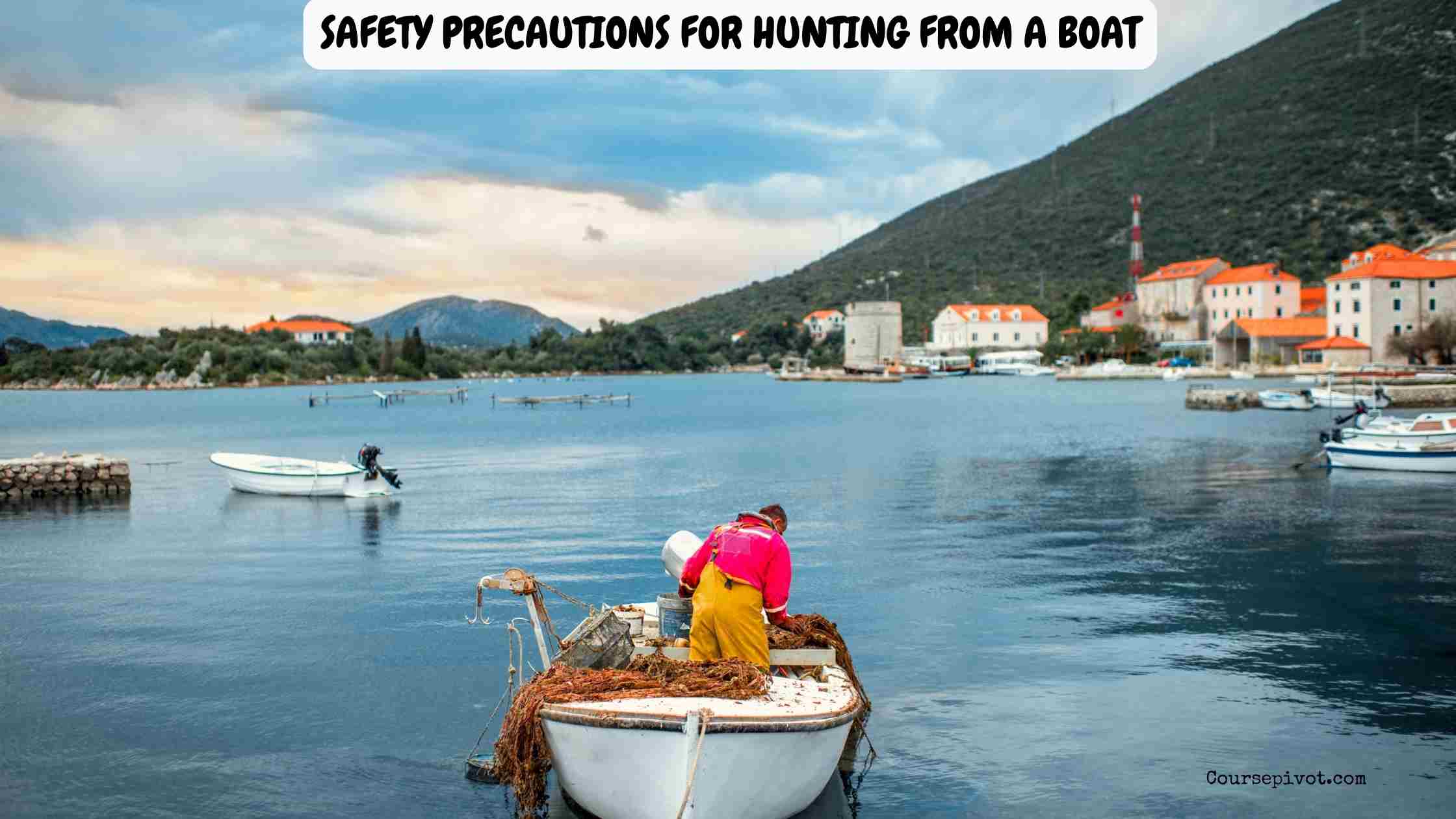
Safety Precautions for Hunting from a Boat
Have you ever pictured yourself gliding across a serene lake, rifle in hand, ready to hunt from a boat? I’ve always been drawn to the thrill of water-based hunting, but a friend’s close call on a shaky canoe made me realize how risky it can be without proper precautions. Hunting from a boat combines the challenges of firearms and water, demanding specific safety measures. In this blog, I’ll explain what safety precautions you should take when hunting from a boat, ensuring you stay safe while enjoying the sport.
Table of Contents
Boating while hunting increases risks like capsizing or firearm mishaps, with over 4,000 boating accidents reported annually in the U.S., per Coast Guard data. This matters because a single mistake can turn an adventure into a tragedy. I’ve learned to prioritize safety after hearing tales of hunters stranded or injured. Let’s dive into the key precautions to keep you secure.
Why should you care? Because proper safety measures protect your life and others’. This article will outline essential precautions, from boat stability to firearm handling, and offer practical tips. Ready to hunt safely from the water? Let’s get started.
Key Safety Precautions for Hunting from a Boat
When hunting from a boat, you must address risks related to water, firearms, and the environment. Here are the critical safety precautions to take:
Wear a Life Jacket at All Times
A properly fitted life jacket is non-negotiable:
- Prevent Drowning: Over 80% of boating fatalities involve non-wearers, per Coast Guard stats. A life jacket keeps you afloat if you fall overboard or the boat capsizes.
- Choose the Right Type: Use a U.S. Coast Guard-approved Type I or III life jacket, designed for mobility and hunting conditions.
- Check Fit: Ensure it’s snug, with all straps secured, and test it in shallow water beforehand.
I’ve seen hunters skip life jackets to “move freely,” but one slip could be deadly. Always wear one, no matter how calm the water seems.
Ensure Boat Stability and Capacity
An overloaded or unstable boat is a recipe for disaster:
- Check Weight Limits: Follow the boat’s capacity plate, accounting for hunters, gear, and game. Overloading causes 30% of boating accidents.
- Distribute Weight Evenly: Place hunters and equipment to balance the boat, avoiding tipping during movement or shooting.
- Inspect the Boat: Check for leaks, ensure oars or motors work, and carry a repair kit for emergencies.
I once saw a boat nearly tip when hunters stood abruptly to shoot. Proper balance saves lives.
Handle Firearms with Extreme Care
Combining guns and boats requires strict safety protocols:
- Keep Firearms Unloaded: Only load when ready to hunt, and unload before boarding or exiting. Store ammo separately.
- Secure Weapons: Use gun cases or racks to prevent guns from falling or discharging if the boat rocks.
- Point Muzzles Safely: Always aim firearms away from people, even when unloaded, and avoid shooting across the boat.
- Limit Movement: Stay seated while shooting to maintain stability, and assign one shooter at a time.
I’ve heard of accidental discharges rocking boats, causing chaos. Treat every gun as loaded, always.
Carry Essential Safety Gear
Be prepared for emergencies with the right equipment:
- Communication Devices: Bring a waterproof VHF radio or cell phone in a sealed bag to call for help. Satellite phones work in remote areas.
- First Aid Kit: Include bandages, antiseptics, and tourniquets for injuries, stored in a waterproof container.
- Navigation Tools: Use a GPS, compass, or map to avoid getting lost, especially in foggy or unfamiliar waters.
- Emergency Supplies: Pack flares, a whistle, and a flashlight to signal for help, plus extra food and water.
I carry a small dry bag with these essentials on every trip. They’re lifesavers when things go wrong.
Monitor Weather and Water Conditions
Unpredictable weather or rough water can turn dangerous:
- Check Forecasts: Review weather reports before heading out, avoiding high winds or storms. Apps like NOAA Weather are reliable.
- Watch for Changes: Sudden squalls or rising waves can capsize small boats. Head to shore if conditions worsen.
- Know the Water: Study tides, currents, and hazards like rocks or shallows to avoid grounding or collisions.
I’ve been caught in unexpected rain on a lake, wishing I’d checked the forecast. Weather awareness is critical.
Follow Boating and Hunting Regulations
Compliance with laws ensures safety and avoids penalties:
- Boating License: Some states require a boating safety course or license, especially for motorized boats.
- Hunting Permits: Carry valid hunting licenses and tags, adhering to season and species rules.
- Local Rules: Some areas ban shooting from moving boats or restrict firearms on certain waters.
I check regulations before every hunt to stay legal. Fines or license loss aren’t worth the risk.
Hunt with a Partner and Inform Others
Never hunt alone, and always share your plans:
- Buddy System: A partner can assist in emergencies, like capsizing or injury. Two sets of eyes spot hazards better.
- Float Plan: Tell a friend or family member your route, destination, and return time. Include boat details and emergency contacts.
- Check-In: Use a radio or phone to update your status, especially in remote areas.
I always text my plans to a friend before boating. It’s a simple step that could save me if I’m stranded.
Why These Precautions Matter
These safety measures are crucial because:
- High Risks: Boating accidents cause 600 deaths and $400 million in damages yearly in the U.S.
- Preventable Injuries: Most incidents stem from human error, like not wearing life jackets or ignoring weather.
- Legal Consequences: Violating regulations can lead to fines ($100–$1,000) or jail time.
- Peace of Mind: Preparation lets you focus on hunting, not survival.
I’ve felt the relief of being prepared after a rough boat trip. Safety turns risks into manageable challenges.
Practical Tips for Safe Boat Hunting
To implement these precautions:
- Practice Boat Handling: Take a boating safety course, like those from the U.S. Power Squadrons, to master navigation and emergency skills.
- Test Gear: Check life jackets, radios, and firearms before leaving to ensure they work.
- Limit Alcohol: Alcohol contributes to 25% of boating deaths—stay sober.
- Train for Emergencies: Learn basic first aid and how to right a capsized boat.
I took a safety course and felt more confident on the water. Knowledge is as vital as gear.
Challenges in Maintaining Safety
Staying safe isn’t always easy:
- Complacency: Experienced hunters may skip precautions, assuming they’re fine.
- Cost: Quality life jackets ($50–$150) or radios ($100+) add up.
- Time: Checking weather or gear feels tedious but saves lives.
I’ve rushed preparations before, but a near-miss taught me to slow down and prioritize safety.
Read our blog on What Companies Are in the Consumer Durables Field?
Hunting Safely on the Water: Key Takeaways
When hunting from a boat, take safety precautions like wearing a life jacket, ensuring boat stability, handling firearms carefully, carrying safety gear, monitoring weather, following regulations, and hunting with a partner. These measures prevent drowning, capsizing, or firearm accidents, protecting lives and ensuring compliance. I’m inspired by how preparation makes hunting safer and more enjoyable, but mindful of the discipline required.
Why should you care? Because one oversight could cost your life or others’. What’s stopping you from prioritizing safety? Gear up, plan ahead, and hunt from your boat with confidence and caution.
Summarized Answer
When hunting from a boat, safety precautions include wearing a life jacket, ensuring boat stability, handling firearms safely, carrying emergency gear, monitoring weather, following regulations, and hunting with a partner to prevent drowning, capsizing, or accidents, ensuring a secure and legal experience.
Cite this article
You can copy and paste your preferred citation format below.
Martin, L. & Arquette, E.. (2025, June 3). Safety Precautions for Hunting from a Boat. Coursepivot.com. https://coursepivot.com/blog/safety-precautions-for-hunting-from-a-boat/



